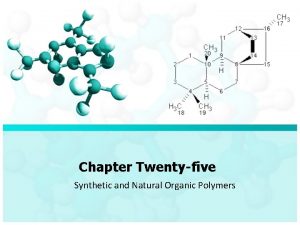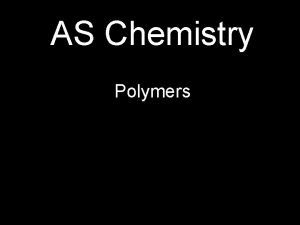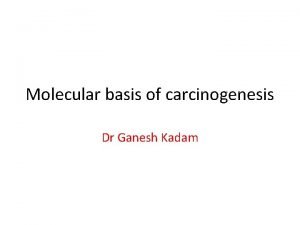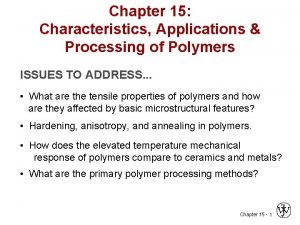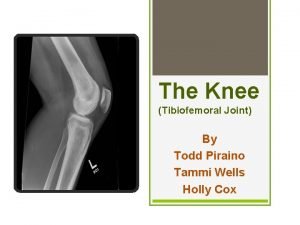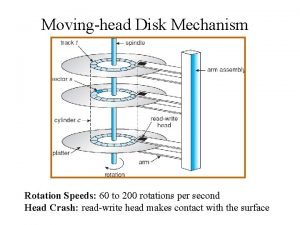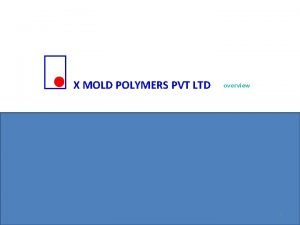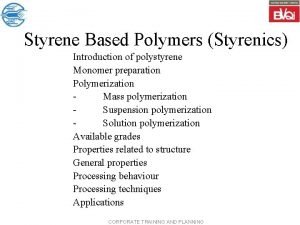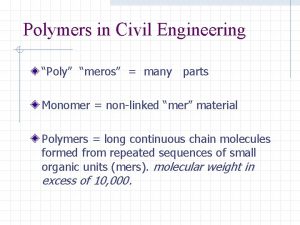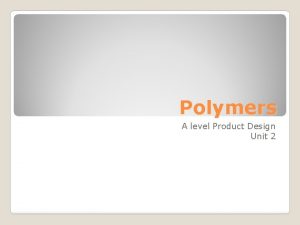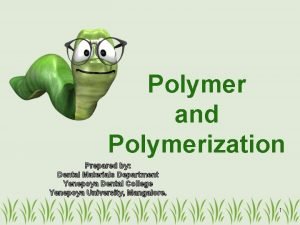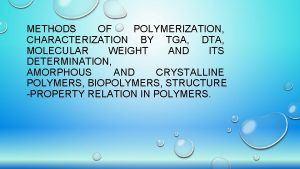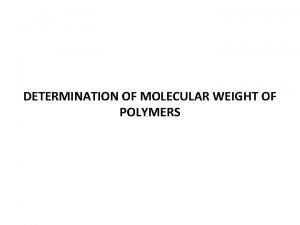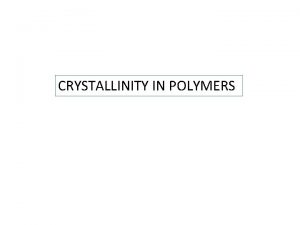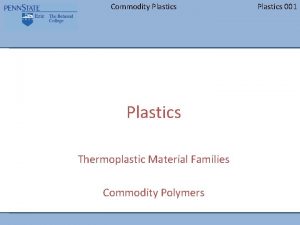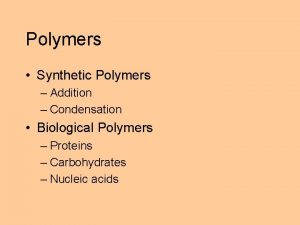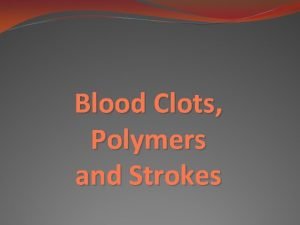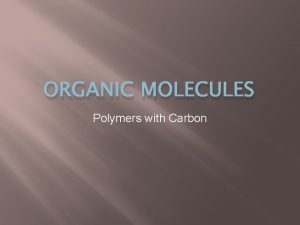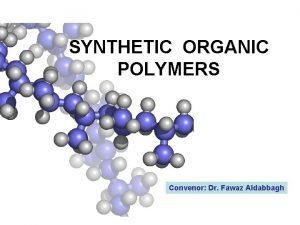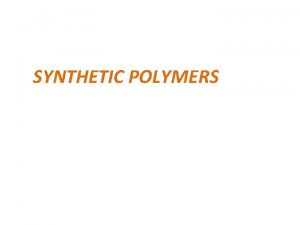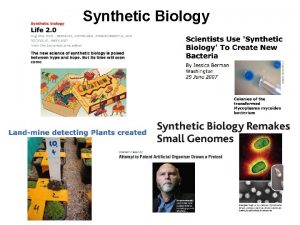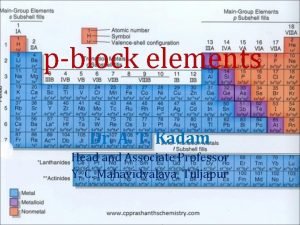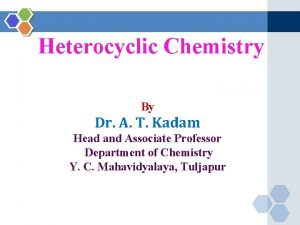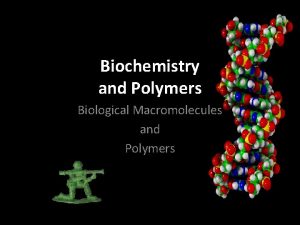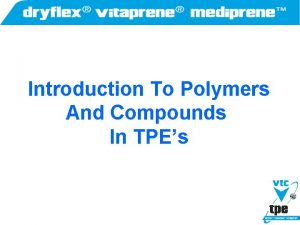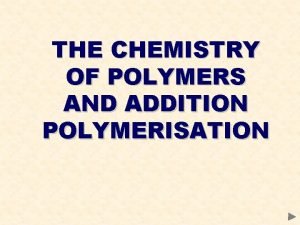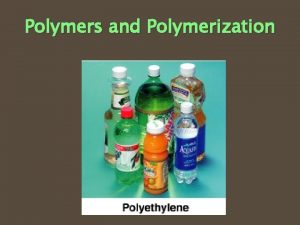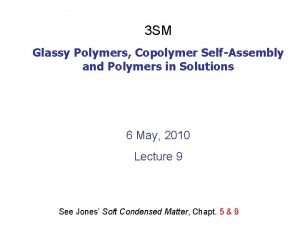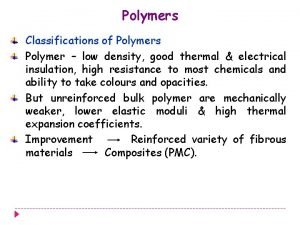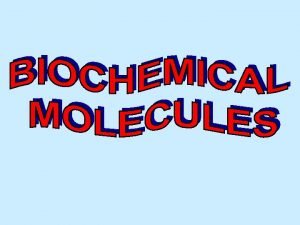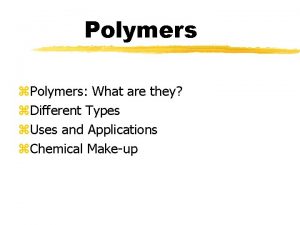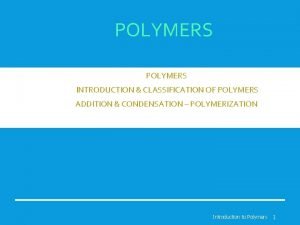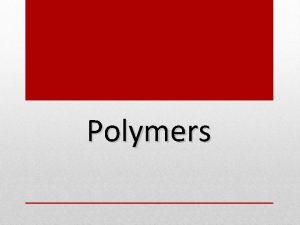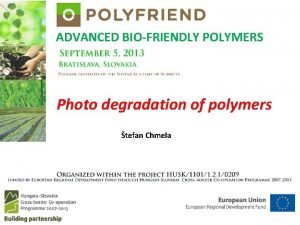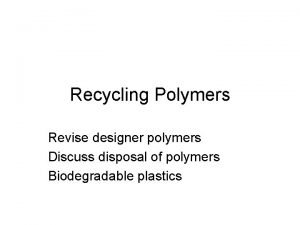Synthetic Polymers Dr A T Kadam Head and


























- Slides: 26

Synthetic Polymers Dr. A. T. Kadam Head and Associate Professor Department of Chemistry Y. C. Mahavidyalaya, Tuljapur

Introduction • A polymer is a large molecule composed of many smaller repeating units. • First synthetic polymers: ð Polyvinyl chloride (PVC) in 1838 ð Polystyrene in 1839 • Now, 250 billion pounds produced annually, worldwide.


Plasticizers • Nonvolatile liquid that dissolves, lowers the attraction between chains, and makes the polymer more flexible. • Example: Dibutyl phthalate is added to poly(vinyl chloride) to make it less brittle. The plasticizer evaporates slowly, so “vinyl” becomes hard and inflexible over time…. . The foggy film that forms on your windshield on a hot day.

Classes of Polymers • Addition, or chain-growth, polymers • Condensation, or step-growth, polymers =>

Addition Polymers • Three kinds of intermediates: Free radicals ð Carbocations ð Carbanions ð • Examples of addition polymers: polypropylene plastics ð polystyrene foam insulation ð poly(acrylonitrile) Orlon® fiber ð poly(methyl -methacrylate) Plexiglas ® ð

Free Radical Polymerization =>

Chain Branching • Low-density polyethylene: soft and flimsy ð highly branched, amorphous structure ð

Cationic Polymerization • Alkene is treated with an acid. • Intermediate must be a stable carbocation.

Anionic Polymerization • Alkene must have an electron-withdrawing group like C=O, C N, or NO 2. • Initiator: Grignard or organolithium reagent. =>

Stereochemistry =>

Properties of Polymers • Isotactic and syndiotactic polymers are stronger and stiffer due to their regular packing arrangement. • Anionic intermediate usually gives isotactic or syndiotactic polymers. • Free radical polymerization is nearly random, giving branched atactic polymers.

Ziegler-Natta Catalyst • Polymerization is completely stereospecific. • Either isotactic or syndiotactic, depending on catalyst. • Polymer is linear, not branched. • Example of catalyst: solution of Ti. Cl 4 mixed with solution of (CH 3 CH 2)3 Al and heated for an hour.

Natural Rubber • Soft and sticky, obtained from rubber tree. • Long chains can be stretched, but then return to original structure. • Chains slide past each other and can be pulled apart easily. • Structure is cis-1, 4 -polyisoprene.

Vulcanization • Process was discovered accidentally by Goodyear when he dropped rubber and sulfur on a hot stove. • Sulfur produces cross-linking that strengthens the rubber. • Hardness can be controlled by varying the amount of sulfur.

Synthetic Rubber • With a Ziegler-Natta catalyst, a polymer of 1, 3 -butadiene can be produced, in which all the additions are 1, 4 and the remaining double bonds are all cis. • It may also be vulcanized.

Copolymers • Two or more different monomers. • Saran®: alternating molecules of vinyl choride and 1, 1 -dichloroethylene. • ABS plastic: acrylonitrile, butadiene, and styrene.

Condensation Polymers • Polymer formed by ester or amide linkages between difunctional molecules. • Step growth: Monomers do not have to add one at a time. Small chains may condense into larger chains. • Common types: ð ð Polyamides Polyesters Polycarbonates Polyurethanes

Polyamides: Nylon Usually made from reaction of diacids with diamines, but may also be made from a single monomer with an amino group at one end acid group at other.

Polyesters • Dacron® and Mylar®: polymer of terephthalic acid and ethylene glycol. • Made by the transesterification of the methyl ester.

Polycarbonates • Esters of carbonic acid. • Carbonic acid is in equilibrium with CO 2 and water, but esters are stable. • React phosgene with bisphenol A to obtain Lexan® for bulletproof windows.


Polyurethanes • Esters of carbamic acid, R-NH-COOH. • Urethanes are prepared by reacting an alcohol with isocyanate. • Polyurethanes are prepared by reacting a diol with a diisocyanate.

Polymer Crystallinity • Microscopic crystalline regions. • A linear polymer will have a high degree of crystallinity, and be stronger, denser and more rigid.

Thermal Properties • Glasses at low temperature, fracture on impact. • At the glass transition temperature, Tg, crystalline polymers become flexible. • At the crystalline melting temperature, Tm, crystalline polymers become a viscous liquid, can be extruded to form fibers.

Thank You…. .
 Synthetic organic polymers
Synthetic organic polymers Poly cyclopentene repeat unit
Poly cyclopentene repeat unit Menopase
Menopase Gene rb
Gene rb Difference between dividing head and indexing head
Difference between dividing head and indexing head Suction lift
Suction lift Application and processing of polymers
Application and processing of polymers Chemsheets gcse 1237 answers
Chemsheets gcse 1237 answers The attacking firm goes head-to-head with its competitor.
The attacking firm goes head-to-head with its competitor. Html teksta noformēšana
Html teksta noformēšana Operation of moving head disk storage
Operation of moving head disk storage Body parts
Body parts What is the tonic syllable
What is the tonic syllable Quad innervation
Quad innervation The tone unit
The tone unit The head of moving head disk with 100 tracks
The head of moving head disk with 100 tracks X mold polymers
X mold polymers Thermal polyaspartate
Thermal polyaspartate Styrene flammability
Styrene flammability Why do different polymers have different properties?
Why do different polymers have different properties? Advantages and disadvantages of thermoplastics
Advantages and disadvantages of thermoplastics 2 types of plastic
2 types of plastic Polymers in dental materials
Polymers in dental materials Homochain polymers
Homochain polymers Polymer molecular weight determination methods
Polymer molecular weight determination methods Factors affecting crystallinity in polymers
Factors affecting crystallinity in polymers Commodity plastic
Commodity plastic
